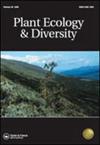Protected from fire, but not from harm: seedling emergence of savanna grasses is constrained by burial depth
IF 1.6
4区 生物学
Q2 PLANT SCIENCES
引用次数: 6
Abstract
ABSTRACT Background The Cerrado is a fire-prone Neotropical savanna and grass seeds are the main component of the soil seed bank. Although grass seeds are presumed to tolerate heat pulses during fires, the assumption that these seeds will be recruited may be an overestimation, since it does not account for factors that limit seedling emergence from the soil. Aims We tested if burial depth constrained the seedling emergence of nine common Neotropical savanna grasses. Methods Seeds were sown at the surface or at 5, 10, 20 and 30 mm in trays filled with cerrado soil. Emergence was assessed daily for 30 days and any remaining non-germinated seeds were tested for viability. Results Seedling emergence decreased with depth, and was positively related to the seed mass. Seven species showed a significant reduction in emergence when sown at 10 mm and only two species emerged from 30 mm. Most non-germinated seeds lost viability after 30 days. Conclusions Burial depth constrained the seedling emergence of Neotropical savanna grasses. Although seeds in the soil are protected during Cerrado fires, they may not generate new individuals, as seedling emergence is limited once a depth of 10 mm is reached and the seeds lose viability within 30 days in humid soil.免受火灾,但不受伤害:稀树草原草的幼苗生长受到埋深的限制
摘要背景塞拉多是一个火灾频发的新热带稀树草原,草籽是土壤种子库的主要组成部分。尽管草籽被认为能在火灾期间耐受热脉冲,但假设这些种子会被吸收可能是高估了,因为这并没有考虑到限制幼苗从土壤中出苗的因素。我们测试了九种常见的新热带稀树草原草的埋深是否限制了幼苗的出现。方法将种子播种在地表或5、10、20和30毫米的装有cerrado土壤的托盘中。在30天内每天评估发芽情况,并测试任何剩余的未发芽种子的活力。结果幼苗出苗率随深度的增加而降低,与种子质量呈正相关。7种种子在10mm播种时出苗率显著降低,只有2种种子在30mm播种后出苗。大多数未发芽种子在30d后失去活力。结论埋藏深度制约了新热带稀树草原草的出苗。尽管塞拉多大火期间土壤中的种子受到保护,但它们可能不会产生新的个体,因为一旦达到10毫米的深度,幼苗的出现就会受到限制,种子在潮湿的土壤中30天内就会失去活力。
本文章由计算机程序翻译,如有差异,请以英文原文为准。
求助全文
约1分钟内获得全文
求助全文
来源期刊

Plant Ecology & Diversity
PLANT SCIENCES-
CiteScore
3.30
自引率
0.00%
发文量
26
审稿时长
3 months
期刊介绍:
Plant Ecology and Diversity is an international journal for communicating results and novel ideas in plant science, in print and on-line, six times a year. All areas of plant biology relating to ecology, evolution and diversity are of interest, including those which explicitly deal with today''s highly topical themes, such as biodiversity, conservation and global change. We consider submissions that address fundamental questions which are pertinent to contemporary plant science. Articles concerning extreme environments world-wide are particularly welcome.
Plant Ecology and Diversity considers for publication original research articles, short communications, reviews, and scientific correspondence that explore thought-provoking ideas.
To aid redressing ‘publication bias’ the journal is unique in reporting, in the form of short communications, ‘negative results’ and ‘repeat experiments’ that test ecological theories experimentally, in theoretically flawless and methodologically sound papers. Research reviews and method papers, are also encouraged.
Plant Ecology & Diversity publishes high-quality and topical research that demonstrates solid scholarship. As such, the journal does not publish purely descriptive papers. Submissions are required to focus on research topics that are broad in their scope and thus provide new insights and contribute to theory. The original research should address clear hypotheses that test theory or questions and offer new insights on topics of interest to an international readership.
 求助内容:
求助内容: 应助结果提醒方式:
应助结果提醒方式:


